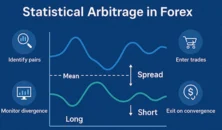
In financial markets, price corrections are a normal part of market movement. However, understanding whether the market is simply pausing or reversing direction is crucial for traders. As a financial risk manager, I’ve seen many traders misinterpret retracements as reversals or fail to identify genuine pullbacks. Let’s break down these terms clearly and learn how to use them effectively in trading decisions.
Is Retracement the Same as Pullback?
Although the terms retracement and pullback are often used interchangeably, they are not completely identical.
A retracement generally refers to a temporary price movement against the main trend,a short-term correction before the trend continues.
A pullback, on the other hand, usually describes a retracement within an established uptrend after a strong price move.
In simple terms:
- Every pullback is a retracement,
- But not every retracement is a pullback.
Traders often use “pullback” when referring to buying opportunities during bullish trends, while “retracement” applies more broadly to any trend direction.
What Does Retracement Mean?
A retracement is a temporary reversal in price direction within a dominant trend. It represents short-term profit-taking, liquidity collection, or a brief correction before the trend resumes.
For example, if EUR/USD is in an uptrend and drops 2% before continuing upward, that 2% drop is a retracement.
Retracements are common and healthy in market movements,they prevent overextension and give traders new entry opportunities.
Traders often use Fibonacci retracement levels (23.6%, 38.2%, 50%, and 61.8%) to identify possible areas where the market may pause or bounce back.

What Is Considered a Pullback?
A pullback is a short-term dip in an uptrend that allows traders to enter the market at a better price before the trend continues.
It shows a temporary loss of buying momentum rather than a full change in direction.
For instance, if a stock rallies from $100 to $120 and then falls back to $115 before climbing higher, that drop to $115 is a pullback.
Experienced traders look for pullbacks as low-risk entry points,especially when confirmed by support zones, volume patterns, or moving averages. Recognizing a pullback helps avoid chasing the price at the peak and improves overall trade efficiency.
What Is the Difference Between a Retracement and a Reversal?
A retracement is temporary; a reversal is permanent (until proven otherwise).
- In a retracement, the main trend remains intact,the price briefly moves against it before continuing.
- In a reversal, the overall trend changes direction entirely, signaling a shift in market sentiment and structure.
For example, if an uptrend forms higher highs and higher lows but suddenly begins to form lower highs and lower lows, that indicates a reversal, not a retracement.
Final Thoughts
Understanding the difference between retracement, pullback, and reversal is essential for managing risk and timing entries.
Retracements and pullbacks are opportunities to join the trend, while reversals warn traders to rethink their position.
By combining price action, trend analysis, and risk management, traders can make smarter, more confident decisions in any market condition.
you can see more articles about trading forex here : Forex Hub







